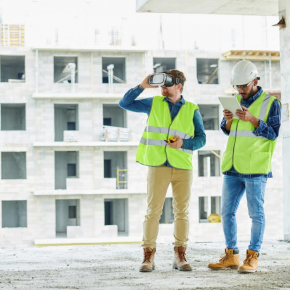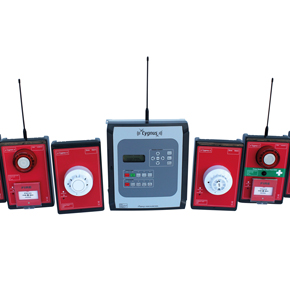
Smart technology equals a safer site with Bull Products
Bradley Markham, director at Bull Products, believes smart technology could be the solution to minimising worker injuries and guaranteeing a safer construction site.
This comes as HSE stats show there were 30.7 million working days lost due to work-related ill health and non-fatal workplace injuries in 2017/18, with workplace injury and illness costing the economy around £15bn a year.
Bull believe when it comes to the use of technology within the workplace, companies have yet to embrace the change or understand the true benefits it could have on the future of the construction industry, and more importantly, workers’ safety.
The past five years has seen technology push the construction industry to become a safer working environment – in particular, the development of wireless technology such as alarm systems are making sites safer.
Today, emergency fire, first aid, and intruder alarm systems have become a vital part of the construction sector due to their flexibility, reliability, ease of installation, and usability.
As existing technology and devices become wireless, there is a dramatic exponential rise in functionality.
Wireless technology is the ideal solution for construction sites and building complexes that contain more than just one building.
In the case of temporary installations, such as construction sites where the work is in progress, wireless fire alarms can be installed and then removed once the work is finished, or moved to another site, ensuring a cost-effective and flexible solution for companies.
As false alarms can cost businesses and fire and rescue services roughly £1 billion a year, and loss of sales and time, wireless systems offer a plethora of benefits to construction companies and a complete safety solution.
Bull believes wireless systems are just the start of smart technology and, if you fast-forward 10 years, the way in which businesses operate and the equipment they invest in will be extremely different.
Recently, there has been a major focus on the use of technology in the workplace and Bradley believes smart technology such as drones, augmented reality and wearable technology will play a vital role in not only improving health and safety on site, but fuelling growth and innovation for businesses.
Virtual reality will enhance health and safety training on site, as it will give workers the chance to reduce accidents by creating simulations of real workplaces and hazards, which will allow workers to be aware of dangerous situations, consequently reducing injuries on site.
Drones will help construction managers inspect a job from above or in places where it is dangerous for a human to go, allowing the technology to spot potential hazards and monitor ongoing activity.
This will provide a time-saving and cost-effective solution as it eliminates the need for an in-person inspection.
Bradley concludes that it is important to start thinking about how smart technology will enhance site safety in the future, as it can ensure best practice on site and build a more efficient construction industry for the future.
Latest news

28th March 2025
Ideal Heating Commercial announces 10-year warranty on Evomax 2 boiler
Evomax 2, the UK’s number one selling commercial wall-mounted boiler from Ideal Heating Commercial, is now available with a 10-year warranty.
Posted in Articles, Building Industry News, Building Products & Structures, Building Regulations & Accreditations, Building Services, Facility Management & Building Services, Heating Systems, Controls and Management, Heating, Ventilation and Air Conditioning - HVAC, Innovations & New Products, Pipes, Pipes & Fittings, Plumbing, Retrofit & Renovation, Sustainability & Energy Efficiency, Videos
28th March 2025
FLIR Si1-LD Acoustic Imaging Camera for Compressed Air Leak Detection
FLIR, a Teledyne Technologies company, introduces the Si1-LD, an industrial acoustic imaging camera that brings faster and more accurate compressed air leak detection to those operating on a modest condition monitoring budget.
Posted in Acoustics, Noise & Vibration Control, Articles, Building Industry News, Building Products & Structures, Building Services, Facility Management & Building Services, Information Technology, Innovations & New Products, Retrofit & Renovation, Sustainability & Energy Efficiency, Thermal Imaging and Monitors
28th March 2025
LIFTEX 2025 Seminar programme announced
Registration has opened for LIFTEX 2025. Now in its 37th year, LIFTEX 2025 is the UK’s only dedicated exhibition for the lift, escalator and access industry and takes place only once every three years.
Posted in Access Control & Door Entry Systems, Accessibility, Articles, Building Industry Events, Building Industry News, Building Products & Structures, Building Regulations & Accreditations, Building Services, Exhibitions and Conferences, Facility Management & Building Services, Health & Safety, Retrofit & Renovation, Security and Fire Protection, Seminars
28th March 2025
MCRMA welcomes ArcelorMittal UK to membership
A UK division of the global steelmaking business ArcelorMittal has become the latest new member of the MCRMA, the industry association representing the metal building envelope sector.
Posted in Articles, Building Associations & Institutes, Building Industry News, Building Products & Structures, Building Systems, Cladding, Facades, Posts, Restoration & Refurbishment, Retrofit & Renovation, Roofs, Steel and Structural Frames, Walls
 Sign up:
Sign up: 
